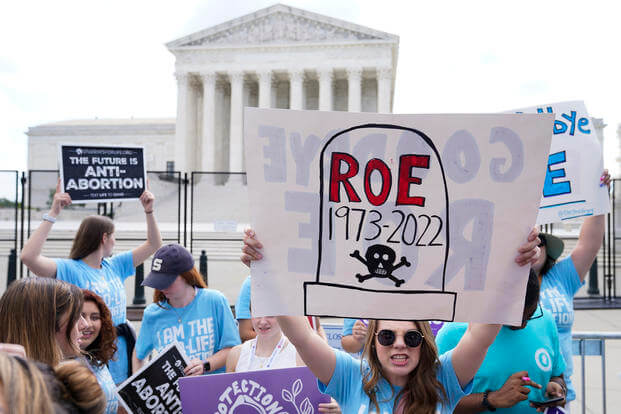Military patients -- especially younger troops and dependents -- sought vasectomies at higher rates in the months after the Supreme Court removed federal protections for abortion, new research has found.
Rates of vasectomy, a male surgical procedure meant to permanently prevent pregnancies, increased among military patients by 22.1% from June through December 2022 compared with the average rates from 2018 to 2021, according to a study published May 18 in the Journal of Impotence Research.
The U.S. Supreme Court issued its Dobbs decision, overturning Roe v. Wade, on June 24, 2022. The decision reversed the 1973 precedent that had protected women’s constitutional right to an abortion, allowing states to write new laws restricting the procedure and making the termination of unwanted pregnancies more difficult for many Americans.
Read Next: Military's Handling of Abuse at Day Cares Under Increasing Pressure from Congress, Inspector General
The study found that military treatment facility patients who received the operation post-Dobbs were more likely to be between ages of 18 and 29, unmarried, and either in the junior military ranks or dependents.
The relative increase was significantly higher in Texas, a state that banned nearly all abortions except in life-threatening situations, at 29.3%, than in Virginia, where abortion procedures remain legal, which had a 10.6% increase, the research also found.
The researchers, with the Uniformed Services University for the Health Sciences and the Henry M. Jackson Foundation for the Advancement of Military Medicine, said the military historically has lagged behind the general population seeking vasectomies as a form of birth control.
But the jump in surgeries in the military health system is similar to the rise in the general U.S. population -- nearly 29% -- following the Dobbs decision.
"We assess that the reversal of Roe v. Wade was a significant driver of a sizable increase in vasectomy incidence within the [military health system], specifically amongst younger and unmarried men," wrote the researchers, led by Dr. Benjamin Pierson, an epidemiology fellow at Uniformed Services University.
"Additionally, state-level restrictions on abortion access may have mediated this effect, with more stringent restrictions resulting in higher rates of vasectomy utilization," Pierson said.
Research published earlier this year found that more young people are choosing surgical forms of birth control -- tubal ligation for women and vasectomies for men -- at higher rates than before the Supreme Court ruling.
That study found 58 more tubal ligations per 100,000 outpatient visits and 27 more vasectomies per patient visit following the decision.
Tubal ligation is a permanent form of sterilization that involves cutting, tying or removing the fallopian tubes.
During a vasectomy, a physician cuts and ties off the vas deferens, two tubes that carry sperm from the testicles to the urethra. According to the Mayo Clinic Health System, the procedure is considered permanent but may be reversible in 60% to 95% of cases.
To conduct the study, researchers used data from the MHS Data Repository and used statistical analysis to understand demographic variables in those who received the procedure pre- and post-Dobbs.
They also factored in the steep decline in surgeries in 2020 in the early months of the COVID-19 pandemic when few military hospitals and clinics were conducting elective surgeries.
The authors noted that they looked only at procedures paid for by the Defense Department and may have missed those who received a vasectomy outside the system.
Another limitation was researchers only counted one vasectomy per patient, so they may have missed individuals who had received one, had it reversed and then received the surgery again. With just 5% of men seeking vasectomy reversal and an even smaller number having a second one, however, they believed the likelihood that the data was skewed by this lack of inclusion "to be rare."
In terms of raw numbers, 96,617 vasectomies were performed in the military health system from 2018 to 2022. More than half were performed on men ages 30 to 39. The Army, the largest service, performed the highest percentage of surgeries, 37%; followed by the Air Force at 28%; the Navy at 21%; the Marine Corps at 9.5%; and the Coast Guard at 4.3%. Another .5% identified as "other."
The study found no significant statistical differences in odds of vasectomy by race.
Pierson and his colleagues said that the findings may signal a shift in attitudes toward vasectomy as a form of birth control among the younger generation since, previously, those who sought it were largely older men who had completed their families.
Further study is needed, they said, to understand the shift.
They added that their findings may help the military health system to understand the impact of state abortion restrictions on facilities and to resource those in states with severe limitations appropriately.
Patients in the military health system may request a vasectomy at age 21, although doctors have the right to refuse for a variety of reasons, including their assessment of the maturity of the patient or their own feelings about reproduction.
The results show that the Dobbs decision has made an impact on men, the authors said.
"This suggests that it may be possible that the release of the Dobbs decision acted as a 'call to action' in the short-term leading those already considering a vasectomy to receive one, but that the effect may be short-lived, leading to vasectomy incidence returning to normal levels over time," the authors wrote.
Related: Birth Control Policies at Boot Camp Affect Military Readiness, Study Finds












